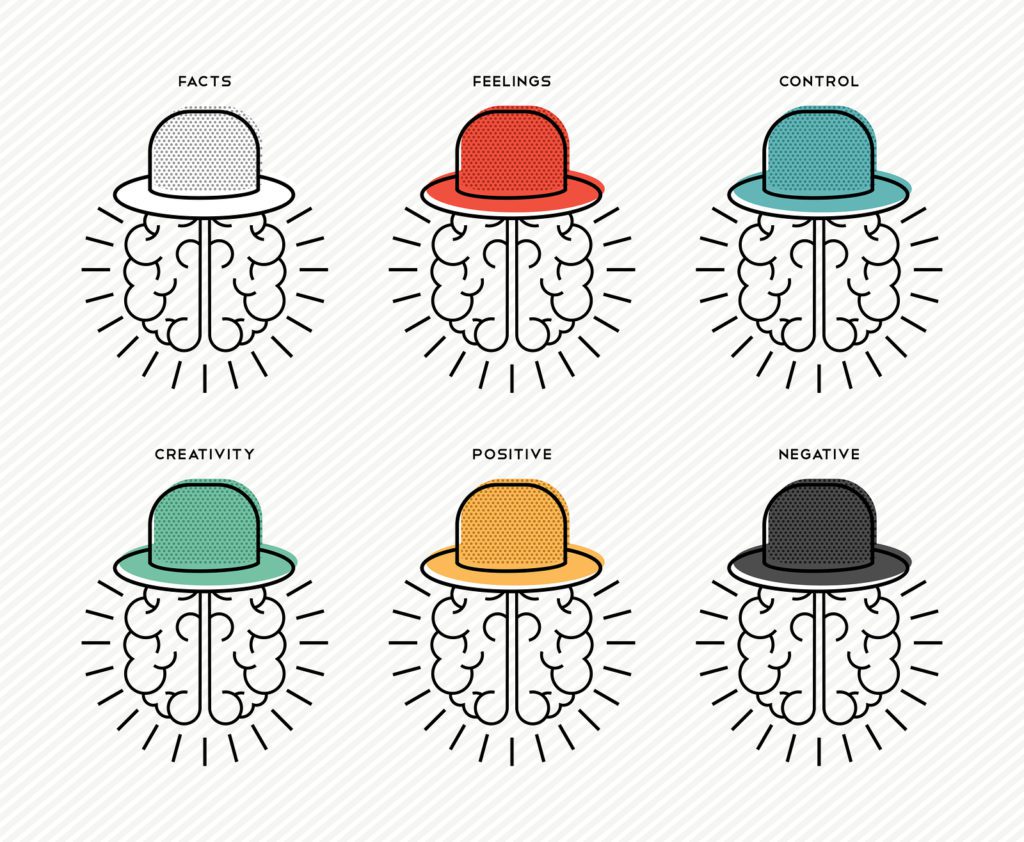Quick Links

Strategic decision-making in portfolio management demands diverse perspectives—the Six Thinking Hats offer PMO leaders a structured framework to overcome cognitive biases and drive more effective organizational outcomes.
What is your natural approach to decision-making? Do you have an instinctive “feel” for what should be done? Or do you take ample time to analyze data and understand the problem before making a move?
Likely, you have a default style that feels comfortable to you. For many of us, that default style is so comfortable that we undervalue alternative ways to make decisions. We may even unwittingly hire people only with similar styles, so that our teams develop a kind of decision-making personality of its own.
However, research on team decision-making suggests that cognitively diverse groups make better decisions.Katherine Phillips’ groundbreaking research at Columbia Business School demonstrated that diverse teams outperform homogeneous ones specifically because they process information more thoroughly and consider multiple perspectives—abilities that are crucial for PMOs managing complex portfolio decisions. This often requires leadership teams to think in ways that challenge their established patterns.
This is the premise of one of our favorite books on group decision making—The Six Thinking Hats by Edward de Bono. In easy, approachable language, de Bono walks us through six thinking processes or “hats.”
All of us are capable of thinking in all six ways, but most of us have one or two hats that we are most comfortable wearing. De Bono recommends that whenever we need to make an important decision, we do two critical things:
We’ve found that for our clients, understanding and implementing the concept of six thinking hats has led to more effective prioritization decisions, stronger project teams, and a sounder overall approach to setting and adapting strategy.
The Thinking Hats represent six unique styles of decision-making: facts, feelings, control, creativity, positive and negative. All six are critical to well-rounded decision-making while lacking diversity can lead to destructive blind spots.
Once you understand the six decision styles, they can be used in three significant ways:
Let’s explore each of these six thinking styles in detail, examining how PMO leaders can leverage them to transform strategic decision-making.
Green-hat thinking sparks creativity and fresh ideas. These thinkers love to explore “what if” scenarios and push boundaries. They shine when teams need breakthrough solutions and get energized by challenging conventional approaches. In strategy meetings, they’re the ones asking, “Why not try something completely different?” and helping teams see beyond the usual playbook.
They Help:
When Overused, They Can:
Red-hat thinking taps into gut feelings and emotional intelligence. These thinkers trust their instincts and can read the room brilliantly. They excel at spotting when seemingly logical plans might face human resistance and can predict how changes will make people feel. They’re often right even when they can’t immediately explain why.
They Help:
When Overused, They Can:
Blue-hat thinking brings order to decision chaos. These thinkers love creating clarity and structure. They excel at guiding teams through complex decisions step by step and turning big ideas into actionable plans. They often ask, “What exactly are we deciding today?” and “Who’s doing what by when?”
They Help:
When Overused, They Can:
Black-hat thinking spots potential problems before they happen. These thinkers have a talent for identifying what could go wrong and challenging rosy assumptions. They strengthen plans by finding the weak spots first and asking the tough questions others might avoid. They’re often heard saying, “Have we considered what happens if…”
They Help:
When Overused, They Can:
Yellow-hat thinking finds the upside in every situation. These thinkers naturally spot potential benefits and possibilities. They excel at building enthusiasm for new initiatives and keeping teams motivated during challenging times. They’re the ones saying “Here’s why this could be huge for us” and “Let’s not lose sight of the opportunity here.”
They Help:
When Overused, They Can:
White-hat thinking grounds decisions in facts and evidence. These thinkers cut through opinions with data and precise analysis. They excel at separating verified facts from assumptions and measuring what really happens versus what was predicted. They often ask, “What do we actually know for sure?” and “How will we measure success?”
They Help:
When Overused, They Can:
Understanding these six perspectives is just the beginning. The real power emerges when you deliberately incorporate all six thinking styles into your PMO’s decision-making processes. Here are three practical ways to start:
The Six Thinking Hats framework doesn’t just improve individual decisions—it can transform your PMO’s decision-making culture. When teams understand and respect different cognitive approaches, they build stronger working relationships and develop more resilient strategies. Portfolio management becomes less about avoiding mistakes and more about making comprehensively considered choices with a clear-eyed awareness of both opportunities and risks.
Interested in implementing this with your PMO team? Download this “cheat sheet” and distribute it to your teams to guide portfolio discussions!
Practical strategies to help you thrive in Leadership, Project Management, and more.

11 East 5th Street
Suite 300
Tulsa OK 74103
918-592-4121
888-392-7101
| Cookie | Duration | Description |
|---|---|---|
| cookielawinfo-checkbox-analytics | 11 months | This cookie is set by GDPR Cookie Consent plugin. The cookie is used to store the user consent for the cookies in the category "Analytics". |
| cookielawinfo-checkbox-functional | 11 months | The cookie is set by GDPR cookie consent to record the user consent for the cookies in the category "Functional". |
| cookielawinfo-checkbox-necessary | 11 months | This cookie is set by GDPR Cookie Consent plugin. The cookies is used to store the user consent for the cookies in the category "Necessary". |
| cookielawinfo-checkbox-others | 11 months | This cookie is set by GDPR Cookie Consent plugin. The cookie is used to store the user consent for the cookies in the category "Other. |
| cookielawinfo-checkbox-performance | 11 months | This cookie is set by GDPR Cookie Consent plugin. The cookie is used to store the user consent for the cookies in the category "Performance". |
| viewed_cookie_policy | 11 months | The cookie is set by the GDPR Cookie Consent plugin and is used to store whether or not user has consented to the use of cookies. It does not store any personal data. |